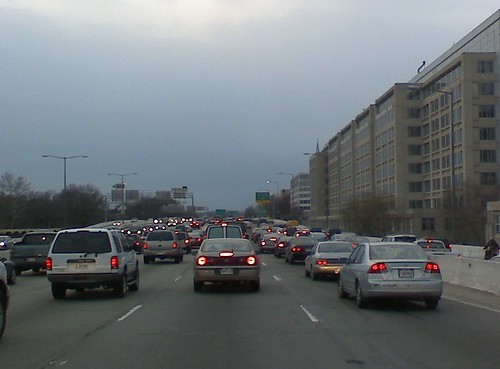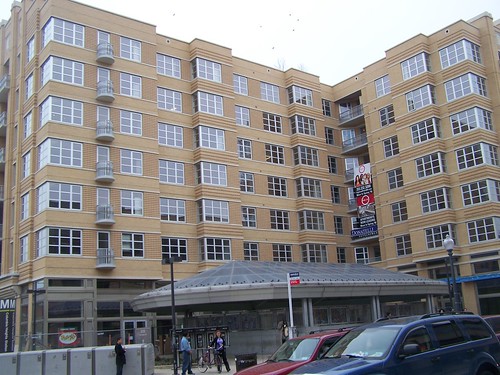Transit oriented duh-velopment: Northern Virginia edition

When I went to college, there was an article one day in the Michigan Daily about the new VP of Development (fundraising) and he said "students become alumni in four years; I don't think they think about that."
As a student activist, my retort was "neither does the university, otherwise they'd treat students better."
That story may not seem relevant to this entry but it is.
Over the past couple weeks there have been some articles about how Virginia legislators want to leverage the land value of new subway stations there. See "Development above the new Fairfax Metro stations: Should preparation begin now?" and more recently "In Arlington, state wants to develop and build over I-66" from the Washington Post. (Note that the Rosslyn locations mentioned in the second piece are much more likely to be able to be developed within 10 years or so, unlike the stations in Fairfax, and eventually Loudoun.)
1. The basic point is that if you want to leverage transit proximity to the best extent possible, you need to design your transit system's footprint and station locations in a manner which makes proximity to transit extremely valuable.
Instead, decisions about routing and not to tunnel in Tysons Corner were more about saving money. But these decisions constrained the ability to do successful "transit oriented development" at station sites.
With regard to the distant subway stations in Fairfax County (and eventually Loudoun County) for the most part they aren't located that well, something I mentioned in a blog post in 2006, "Why are people so damn good about asking the wrong question?" And where they should be underground, like in Tysons Corner, they aren't.
In the cited blog entry, the issue was why don't people living near Vienna Metro Station use it. The answer is complicated. The station isn't sited in a manner that encourages use, it's a disconnected pod. That's typical of stations sited on freeways. See the past blog entry "Dangerous minds."
 Right: one of the Columbia Heights station entrances abuts condos. The other condos and retail, and both are across the street from DC/USA and accessible to many thousands of dwelling units within one-half mile. (Note that WMATA should have sold the air rights over this part of the station, but didn't.)
Right: one of the Columbia Heights station entrances abuts condos. The other condos and retail, and both are across the street from DC/USA and accessible to many thousands of dwelling units within one-half mile. (Note that WMATA should have sold the air rights over this part of the station, but didn't.)So the value in living or working by the station is reduced, compared to other kinds of agglomeration benefits present in other locations, where transit access is better integrated into community fabric, such as in Downtown DC or along the Wilson Boulevard corridor in Arlington County, Virginia, or a station like Columbia Heights.
Typically, freeway based railroad and transit services don't perform all that well in terms of ridership and economic development, although there is no question that it is easier to obtain right of way, which was the case for I-66 in Fairfax County for stations like Vienna, and is the case for the Dulles Toll Road (Rte. 267), which is owned by the Washington Metropolitan Airports Authority, and the Dulles Greenway Toll Road, which is privately owned, and extends beyond the airport. (Virginia for ideological reasons, is into toll roads.)
The problem with the Toll Road routing for the subway is that it puts stations some distance away from key activity centers.
2. Plus in order to move development along proximate to transit stations it helps for there to be a limited amount of build out capacity in the general area. That is definitely not the case in Greater Tysons/Reston and Loudoun County.
There are millions and millions and millions of square feet of development capacity and as it is there isn't enough demand for it. See "Fairfax still wants a real center at Vienna MetroWest" from GGW and "Montgomery office market posts small gain: Rest of D.C. region suffers" from the Gazette. The Gazette article is based on releases from Cassidy Turley, a commercial space brokerage and research firm (Northern Virginia Outlook, Suburban Maryland Outlook).
It's expensive to build mixed use. It's harder to finance. It's expensive to build tall as well. And building over transit stations is even more complicated and costly. Plus, it's expensive in time (and money) to create joint-development deals between public and private entities.
Left: compare the location of the Vienna Metro Station to the Columbia Heights Station. Flickr image by Andy961.
All these issues conspire to make it a long time before it becomes worthwhile to pursue development deals at the more complicated locations such as the Metro Stations, with the exception of Rosslyn, where there is already significant development, the freeway is located below grade, and the indicated locations are next to the existing conurbation.
That being said, even in good locations it takes a long time, because it is more expensive, involves sign off from the US DOT, etc
3. There is one instance where such a project is proceeding in DC. See "I-395 air rights now Capitol Crossing" from the Washington Business Journal. This project has been on the drawing board since 1988.
And eventually, because of demand and proximity to the US Capitol, it is likely that the Southeast-Southwest Freeway will be decked in the places where the freeway is below grade.
Labels: real estate development, transit and economic development, transit oriented development, transportation planning, urban design/placemaking




10 Comments:
somewhat off topic, but Kroger just agreed to buy harris teeter.
Don't know the implications of that...
In terms of the various air rights projects, it is a useful shift in framing. No question the air rights are valuable, and it good to see Virginia starting to recogonize that. The complete failure of the betlway HOV lanes (a democratic idea, btw, thank Timmy) is probably helping that shift.
I was out in the Mosaic district a few weekends ago. Very much like Union Market? Above ground metro stations are tough in the summer. And winter. Could you have a Circulator style busing to get around gallows road? Maybe. Say from the metro station to 50.
1. Didn't hear yet about H-T and Kroger although that makes sense to me. Most of the trade speculation seemed off to me. E.g., Ahold has no experience with upscale grocery selling, and when I talked to some Ahold execs, they scoffed about an H-T/Ahold combo ever happening. (they could have been playing me too, though.)
Similarly, Cerberus didn't make any sense. They want to buy problems for a lower price that can be rectified and sold for a higher price. Limited opp. to acquire undervalued assets with a play for H-T, anyway...
2. I still haven't been to the Mosaic District. But wrt Union Market, I don't like it much. It feels too processed and you don't see much food. It doesn't have the same kind of vitality as do other for profit public market type places like Chelsea Market in NYC. But that's me. Maybe I haven't been there at the right times.
3. wrt your specific point about the land value and monetization, that creates an interesting dynamic in the new extensions, because likely WMATA won't get much ownership interest in the development rights, depending on how the stations are conveyed.
And this disses WMATA/"us" "the people" who have already invested in the system, because the value of transit proximity in the extensions is in part generated by the value inherent in the rest of the system.
The legacy portion of the system should be able to receive some of the financial benefit from the higher values enjoyed by the new stations.
The big obstacle to urbanism in Tysons Corner is not the elevated Metro, but the roads. Without narrowing Routes 7 and 123 and removing the cloverleaf where they cross, putting the Metro underground would have done little good.
@benRoss, I could say the same about K st.
Not trying to pretend it isn't a traffic sewer in Tysons, but if there is something worth going to, people will cross the road.
@RichardLayman, yep that is exactly what I meant about mosaic as well with the union market comparsion.
In terms of WMATA and land development, for a long set of reasons they are extremely poor at it.
" I could say the same about K st."
And you would be wrong.
K Street is not even close to the kind of barriers that the major Tysons roadways present. Not even close.
Sidewalks exist and crosswalks exist even on the busiest portions of K Street. It's not ideal in places, but it's possible.
There is no sidewalk at all between the Malls and Capital One along 123. Nothing. There aren't any alternative routes, either.
what came first the chicken, in this case "the roads" or the egg, in that case, "the superblocks" ?
You're right that the roads are key. OTOH, the roads could change especially if the subway were underground. It puts less pressure on them to make quantum changes in the urban design, although such changes are proposed long term.
It's not unlike the problem at White Flint.
And seeming improvements in "North Bethesda" like with that big building with the Whole Foods at the lot line/sidewalk aren't really improvements to placemaking and urban design in the short run because it puts the sidewalk right up up against the busy road.
http://www.marylandroads.com/Traffic_Volume_Maps/montgomery.pdf
50,000+ ADT
No, the Metro has nothing to do with this. The primary reason the walking paths stink in Tysons are the freeways and their associated interchanges. Putting the Metro underground doesn't magically make the cloverleaf between 495 and 123 disappear.
We're not even talking about quantum changes in urban design, we're talking about any sort of legal sidewalk. There is _nothing_ that connects the McLean and Tysons Corner stations.
The larger point is that even if there were a quantum change, you're not going to get rid of those freeways, nor are you going to eliminate the need for those freeways to interchange with the busy cross-streets (like 123). Even with the most urban-friendly interchange designs, it's still going to be a sub-par walking experience and that has nothing to do with the elevation of the Metro stations.
Point being: elevated rail there is perfectly fine. I'd rather spend energy on attempting to fix the road network, or on ensuring that the elevated rail is of a quality design.
... but don't you think over the coming decades, and it will take 20 years to begin seeing real impacts, and 40 years to get major impacts, that the changes in the urban design plan and practice for Tysons, combined with Metro, will make a difference.
It will also be interesting to see what happens with Reston Town Center, although without the station being directly there, the positive benefits are somewhat minimized. (Think of how Arlington has 4 stations over two miles between Courthouse and Ballston.)
I think that the Tysons changes and what is happening in White Flint are some of the most significant suburban planning initiatives in the US.
I am just not likely to see the changes, unless I live to be as old as Robert E. Simon.
http://urbanplacesandspaces.blogspot.com/2013/01/tysons-white-flint-and-continued.html
With Virginia being rich in history, good opportunities (especially in tourism) and a low cost of living, it's possible to live in comfort here - whether you are a writer, an actor, a painter, a restaurateur, a coffee and sandwich shop owner, a factory worker or a plumber. Manassas, for instance, the site of the Battle of Bull Run, is a particularly good place for those who can see the opportunities.
homes for sale in bristow virginia
Wow, what an amazing giveaway !! Thanks so much,click it...: https://www.dosepharmacy.com
Post a Comment
<< Home